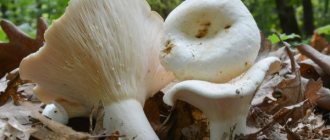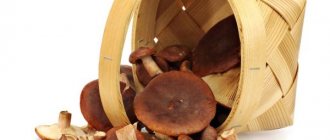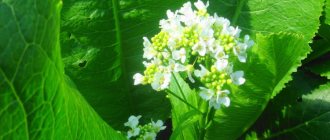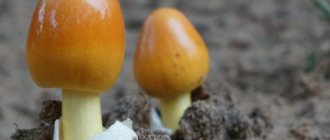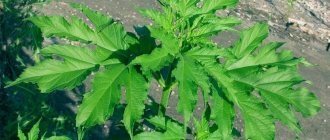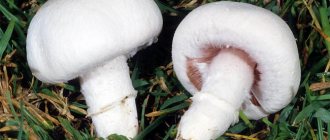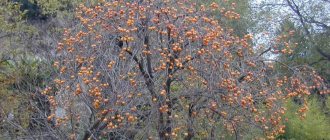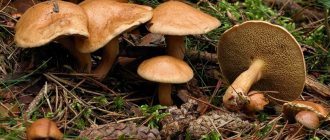Description of the mushroom
There are more than 250 species of these mushrooms. They all have a cap and a stalk, but their shape, size and color depend on the type of mushroom. Most talkers are classified as little-known edible and conditionally edible mushrooms; in terms of nutritional value they are included in category 4. Before use, they must be boiled in water, the first broth is drained.
Cap part of the mushroom
It does not grow to large sizes, reaching an average of 3-6 cm in diameter. In young mushrooms it has the shape of a hemisphere, but with age it levels out and takes on a depressed shape.
The surface is smooth and dry under normal climatic conditions, but during frequent rains it can be covered with a slimy film. Sometimes on the upper part you can see spots that look like mold - these are the remains of mycelium. The color ranges from white to pink-brown and even ocher, depending on the species. The color tends to lighten at the edges of the cap.
Records
The color of the plates also varies. They descend along the stem, and can be frequent or rare. They produce white spore powder.
Leg
The height and diameter of this part of the fruiting body of the mushroom also depends on the variety, but on average the height is 6-8 cm and the diameter is 0.5-3 cm.
Pulp
White in color, dense in young mushrooms and loose in older mushrooms.
Spore powder
Pure white or creamy-whitish color.
Talkers whitish, whitish and reddish-brown
White talker in the photo
Clitocybe candicans in the photo
White talker (Clitocybe candicans). The cap is 1.5–5 cm in diameter, convex at first, later straightened to concave, the edge is thin and drooping. The skin is at first slightly mealy, then shiny and smooth. The color is white, sometimes with a faint pink tint. The plates are frequent, slightly descending, white. The pulp is thin, white, the smell is inexpressive, the taste is pleasant.
The stem is 2–4 cm high, up to 0.5 cm in diameter, cylindrical, often bent at the base, tomentose. The color is white or yellowish.
Spore powder. White.
Habitat. In forests of various types on litter and needles.
Season. August – November.
Similarity. With other small white talkers, which you should refrain from collecting.
Use. The mushroom is suspicious, in different sources it is designated as poisonous, inedible, non-poisonous. According to some reports, it contains muscarine.
The whitish talker in the photo
Whitewashed talker in the photo
Whitish talker, whitened talker (Clitocybe dealbata). The cap is 2–4 cm in diameter, convex or flat, later funnel-shaped, often irregular in shape, with a sinuous, uneven edge. The skin is smooth, dry, with a slight powdery coating. The color is whitish, with faint grayish zones along the edge in the form of concentric circles formed when the plaque cracks, with buffy spots at maturity. The plates are adherent or descending, white or grayish, then cream. The pulp is thin, white, the taste is inexpressive, the smell is weak.
The stem is 2–4 cm high, up to 1 cm in diameter, cylindrical, slightly thickened towards the base, whitish or cream-colored, at first solid, later hollow.
Spore powder. White.
Habitat. In meadows, pastures, and forest grassy edges.
Season. Summer autumn.
Similarity. The mushroom is extremely similar to cherry (Clitopilus prunulus), which has a much stronger floury odor and whose blades acquire a pinkish tint when ripe.
Use. A very poisonous mushroom due to its high muscarine content.
Caution: if you have the slightest doubt, it is better to refuse to collect white talkers altogether.
Talker cracking in the photo
Reddish talker in the photo
Cracking talker, Reddish talker (Clitocybe rivulosa). The cap is 2–5 cm in diameter, convex at first, later straightens out, depressed in the center, covered with a powdery white coating, which cracks as the cap grows, revealing the main color – cream or reddish-reddish. As a result, the surface is covered with unclear concentric zones. The plates are adherent, frequent, reddish-white, later creamy. The pulp is thin, the taste is inexpressive, the smell is inexpressive.
The stem is 2–4 cm high, 0.4–0.8 cm in diameter, the same color as the cap or reddish-brown, slightly felt-like at the base.
Spore powder. White.
Habitat. In forests, gardens, parks, often along paths, along the sides of ditches.
Season. From late summer to autumn.
Similarity. With other small white talkers, with edible cherry (Clitopilus prunulus), which has a floury smell and pink leaves.
Use. The mushroom is very poisonous.
Caution: do not collect small white talkers if you are not sure of the exact definition.
Red-brown talker in the photo
Hat with a diameter of 5–9 cm in the photo
The talker is red-brown. The cap is 5–9 cm in diameter, wide-funnel-shaped, red-yellow, reddish-brown or rusty-spotted, often hygrophanous. The plates are frequent, delapidating, cream or yellow-rusty. The pulp is thin, brittle, hard, reddish or fawn, the smell is sour, the taste is tart.
The leg is 3–5 cm high, up to 1 cm in diameter, reddish, lighter than the cap, hard.
Spore powder. White.
Habitat. In coniferous, less often deciduous forests.
Season. This is an autumn species that grows until frost persists.
Similarity. Similar to the waterspotted talker (C. gilva), growing in deciduous and coniferous forests, lighter in color and having watery spots on the surface; on the edible funnel talker (C. infundibuliformis), which has white plates.
Use. Previously, the red-brown talker and the water-spotted talker were considered edible, but later muscarine was discovered in them. Information in the literature about their edibility is very contradictory; moreover, their taste is mediocre, and therefore we do not recommend collecting these mushrooms.
Look at the photos of talker mushrooms, the description of which is presented on this page:
Large smooth Govorushka bent in the photo
Rare edible mushroom Govorushka orange in the photo
The whitish talker in the photo
- Author: admin
Rate this article:
- 5
- 4
- 3
- 2
- 1
(22 votes, average: 4.3 out of 5)
Share with your friends!
Types of talkers
There are a huge variety of talkers, it is impossible to list them all; of the most famous types, only the most popular can be distinguished.
Curled or red
The most famous representative of this family. It often grows in large colonies in different forests. The reddish cap grows up to 20 cm. It changes shape as it grows - in young talkers it is convex, in more mature mushrooms it is funnel-shaped, the edges are slightly lowered and curl down. The skin on the cap is smooth, yellowish-brown in color, but fades with age and becomes fawn in color with rusty spots. The yellowish leg is 15 cm long and no more than 3 cm thick. The shape is cylindrical, thickened towards the bottom.
They grow in Germany, Poland, France, Spain, Italy, Russia, Belarus and other countries of the Northern Hemisphere with a temperate climate. It bears fruit actively from the first days of July, and the last mushrooms can be found even in October. A favorite place is along the edges of paths, on forest edges and grassy meadows, in the depths of deciduous, coniferous or mixed forests on a litter of fallen leaves or mosses. They grow in arched clumps.
Orange or cocoshka
Another name is false chanterelle. There is a resemblance to a real chanterelle, but differs in its thin and dense flesh and bright color.
The mushroom cap is small, 2-5 cm in diameter; initially it has a convex shape, but over time it becomes flat, with outstretched edges, slightly curved at the ends. The color is orange-ocher, fading to pale yellow, but the middle remains bright yellow and the edges become almost white.
The leg is cylindrical, length - up to 5 cm, diameter about 0.5 cm, yellow-orange, brighter than the cap.
It bears fruit from the beginning of August to the end of October, it can be found in coniferous and mixed forests, and can grow either singly or in groups.
Only the caps of young cocos are eaten, since their legs are tough, and old caps become tough and tasteless.
Gigantic
Record holder among other species for the largest cap and stem. The mushroom is completely white. The cap usually grows up to 15 cm, but it is quite common to see mushrooms with 30 cm caps. At first it is convex, then it takes the shape of a funnel with the edges turned down. The size of the cap does not lag behind the leg. It is 4 cm thick and 8 cm long. The pulp is white and dense, but has practically no taste or aroma.
The giant talker can form “witch circles,” although it is believed that mainly poisonous representatives of the mushroom kingdom grow this way. The mycelium growing in the ground spreads evenly in all directions, which is why it occupies the area in a ring. Therefore, mushrooms grow along the border of the mycelium, located in a circle.
It grows in forest glades in North America, Europe and Russia. It bears fruit from late August to October, and can sometimes be found even in October.
Goblet
The most common in Russia. It settles on rotten wood or forest floors. Mushroom pickers go to the forest for it in August - September. The gray-brown cap is shaped like a cup or glass, with a diameter of 3–8 cm. The stem is very thin, reaches a maximum thickness of 0.6 cm, and a length of 10 cm. The pulp is watery, grayish-brown in color.
Voronchataya
It grows both singly and in groups in forests, meadows and pastures. The mushroom harvest occurs between July and October. The hat is small (10 cm in diameter). Initially, it is convex with a tubercle in the middle and curled edges. Then the mushroom gradually unfolds and forms a deep funnel, the edges of which are curved outward.
The cap is thin, light yellow or reddish in color. The leg, which has the same color as the cap, is of medium length and does not exceed 8 cm in length. At the base there is a slight thickening with white hairs. The pulp also has almond notes, is white, and not dense. The plates of the hymenophore are located frequently and strongly descend onto the stalk.
The species is widespread in the European territory of Russia, Western Siberia, the North Caucasus, as well as most European countries.
Smoky
The mushroom is found in spruce and pine forests from late summer to November. It grows in groups. The hat resembles a gray pillow. Young mushrooms may have a gray-white coating on the surface, which is easily removed. The leg grows up to 12 cm in length, 2-3 cm in diameter. There is a slight thickening at the base.
The pulp is white, has a floral-fruity aroma, fleshy, soft in young mushrooms, more fibrous and tough in mature ones.
Although the smoky talker is a conditionally edible mushroom, its consumption can cause serious harm to the gastrointestinal tract, since the mushroom contains nebularin, a cytotoxic substance.
Smoky white
Slightly different from its brother - the smoky talker. The cap of representatives of this species reaches a diameter of up to 20 cm, but usually no more than 15 cm. In young mushrooms it has the shape of a hemisphere, convex with a folded edge, over time it becomes convex-prostrate, fleshy, thick, the color is yellowish-whitish or dirty -white, can be gray in dry weather.
The leg is thick, can grow up to 8 cm in length, 1-3 cm in diameter, club-shaped, expanding over time towards the base, grayish, almost white.
The pulp is fleshy, dense, and has a characteristic fruity aroma.
It bears fruit from early September to November, but the peak occurs in September. Found in coniferous and mixed forests.
This species has some similarities with the poisonous White Row, which can be distinguished by its unpleasant aroma.
Club-shaped
An unusual mushroom that looks like an exotic jug. It settles in forests on coniferous forest floors. The convex dark gray cap straightens as the mushroom grows, diameter is 4-8 cm. The stem at the base is strongly swollen, and resembles an inverted club, length is 3-6 cm.
The pulp is ash-gray in color, but tastes very pleasant and has a pronounced mushroom aroma. Mushrooms grow in families, often fused with legs. It grows in coniferous forests from July to October, sometimes found in deciduous and mixed forests.
Fragrant
Refers to conditionally edible mushrooms, used in pickled or boiled form (cook for at least 10 minutes). It grows in coniferous and mixed forests, but is quite rare. The period of active fruiting is from the first half of September to the first half of October. The cap part of the mushroom is small, up to 6 cm in diameter, at first convex in shape, later becoming concave, with a drooping edge, color yellowish-gray or pale ocher. The stem is the same color as the cap, thin, can reach 5 cm in length, and is cylindrical in shape. The pulp is thin, watery, whitish in color.
There is a similarity with the fragrant talker, but differs from it in the yellowish color of the cap.
Fragrant
It is collected very rarely, although it is a very aromatic mushroom that smells like anise. But due to its strange bluish-green color, many mushroom pickers consider it poisonous. The cap is small - does not exceed 7 cm, flat with a tubercle in the middle. It is an unattractive bluish-greenish color, becoming gray-yellow with age.
The cylinder-shaped leg is painted, as is the cap. It reaches 5 cm in length. The plates on the lower surface of the cap part are pale green. The flesh is fleshy, but the color repels mushroom pickers - it is pale gray with a green tint. Even if you boil the mushrooms, the color will not change.
Abundant fruiting occurs from the first ten days of August to the second half of October. It inhabits deciduous, coniferous or mixed forests of Western Siberia, Central and Eastern Europe, and the European part of the Russian Federation.
Winter
The mushroom grows in the European part of the post-Soviet space; it can also be found in the Caucasus, the Far East, Western Europe, South America and North Africa. Fruiting period is late autumn.
The convex cap reaches 5 cm in diameter, later taking on a depressed shape. The edges are thin and slightly sinuous, the color of the cap is smoky or olive-brown. The cylindrical leg reaches a height of 4 cm, the color matches the color of the cap.
Snezhnaya
Some mushroom pickers claim that the snow talker is an edible mushroom, but officially it belongs to the category of conditionally edible.
The diameter of the cap part is up to 4 cm, initially it is convex, with curved edges, over time it becomes depressed, smooth, the color is gray-brownish, it can be gray-brown, the middle is darker than the edges. The leg is thin, up to 4 cm in length, cylindrical, light in color.
The flesh of the mushroom is dense, hard in the stem, and may be odorless or with a faint cucumber tint.
The fruiting period is short - from the beginning to the end of May, lives in light spruce or coniferous forests, and is not found every year.
The talker is bent and gray
The talker is a bent lamellar mushroom.
(Clitocybe geotropa) pictured
The talker is bent . Grows singly and in large groups forming wide rings from early July to mid-October. It grows in the form of “witch circles” on the edges of forests, near roads and in bushes. It produces large yields on calcareous soils.
The mushroom is edible. A large, smooth depressed gray-yellow cap 12-20 cm, initially convex with a small tubercle, then becomes funnel-shaped with a tubercle in the center. The plates are often descending, initially white, then yellowish-pinkish. The stem is dense, club-shaped, 10-20 cm long, 2-3 cm thick, the same color as the cap, pubescent with mycelium at the bottom. The pulp is thin and dry. The flesh of young mushrooms is white, while that of mature mushrooms is brown and has a strong, unpleasant odor. In the cap it is dense, elastic, in the stem it is loose. No milk.
Fruits from August to October.
Knowing the description of the talker mushroom of this species, you will never confuse it with the poisonous entoloma (Entoloma sinuatum), whose cap is not funnel-shaped and without a tubercle, the leg is not club-shaped, and the flesh has a rancid odor. Entomola may cause stomach upset.
Young edible talker mushrooms are quite tasty, old ones are a bit harsh, but quite edible when mixed with other mushrooms.
The talker is gray, or smoky in the photo
(Clitocybe nebularis) in the photo
Gray or smoky talker (Clitocybe nebularis) is an edible mushroom. The cap is 7-15 cm, initially convex with a small hump, then becomes flat with a small depression, thick, fleshy, ash-gray or gray-brownish. The plates are often white-grayish or yellow-grayish. The leg is strong fibrous, thickened below, white-grayish short, 2-4 cm thick. The pulp emits the smell of toilet soap. In the cap it is thick, fleshy, in the stem it is watery and loose. Spore powder is white.
Grows in coniferous and deciduous forests, in bushes, near dead wood. Often in large groups.
Fruits from August to November.
It has no poisonous or inedible counterparts. The mushroom is difficult to confuse with other species, as it is distinguished by a pungent odor, late appearance, and easily crushed plates in mature specimens.
Smoky talker belongs to the fourth category of mushrooms. Without pre-treatment, which consists of boiling for half an hour, it can cause food poisoning.
Previously, the mushroom was considered unconditionally edible, but now views on its edibility have changed. The fact is that in some people, when consumed (especially young specimens), it can cause stomach upset, excessive sweating, and breathing difficulties. Strongly accumulates salts of heavy metals. In any case, it requires mandatory preliminary boiling and should not be abused.
If all culinary standards are followed, the mushroom becomes absolutely harmless and can be salted and pickled. In folk medicine, the healing properties of talker, whose tissues contain a natural antibiotic, have long been known.
What mushrooms can be confused with - poisonous varieties
There are a number of poisonous and deadly varieties of talkers. You need to be able to distinguish them from edible varieties.
Waxy talker
The cap of this mushroom is dirty white, watery circles with a tubercle in the middle are noticeable on its surface, the funnel is not as deep as compared to the funnel-shaped talker, the poisonous mushroom does not have a pleasant smell.
Also, this toxic mushroom should be distinguished from the edible cherry blossom. The hat differs from the pendant in that in the center of it you can see a wide hump-shaped tubercle, the edges are wavy, sometimes even fluffy. The leg is slightly bent, fluffy at the base.
Brown-yellow
The cap body of the mushroom can reach a diameter of 10 cm, but specimens with a cap of 3-6 cm are more common. The shape is convex, with a barely noticeable tubercle and a curved edge. When drying, small wet spots appear, which is a distinctive feature of the fungus. The color is yellowish-brown, yellowish-ocher, reddish, fading to cream, often with rusty spots.
The leg is up to 5 cm long, diameter - 0.5-1 cm, smooth, barely narrowed towards the base, yellow-ocher or pale ocher color.
Fruits from the beginning of July to the end of October, found in coniferous and mixed forests, in groups.
It is similar to an inverted talker, but since both mushrooms are classified as inedible, their distinction is not particularly important.
Talker inverted
The diameter of the mushroom cap can reach 10 cm, initially it is convex, over time it acquires a wide funnel-shaped shape, the color is red, brick-rusty, sometimes with dark rusty spots.
The leg can reach up to 6 cm in length, is rigid, the color matches the color of the cap, a little lighter.
It grows from the beginning of August to the end of October in coniferous forests, groups forming the shape of rings, or growing in a row.
The inverted talker is considered poisonous due to the content of poisons similar to muscarine.
Translucent talker
Unknowing mushroom pickers may confuse it with other representatives of the genus. The cap is round, nutty or ocher in color; after rains, the surface is covered with a mucous film and becomes sticky. The pulp is white, fleshy. The leg is cylindrical, approximately 3.5-4 cm long. Like the cap, it is colored in ocher, brick tones, darkens with age and becomes dark red or bright brick.
It is found in coniferous and deciduous forests, likes to settle on infertile soils, and is distinguished by the fact that it grows in large groups.
Pale or grayish
Externally, young mushrooms of this species are very similar to winter talker. The cap is more lumpy than that of the winter talker; over time, pits appear on it. The diameter reaches a maximum of 5 cm. The leg is hollow, the color is also slightly different from the winter one - at first it is grayish with a whitish coating, then grayish-brownish. The pulp is watery, odorless.
It grows in fallen oak or birch leaves; some specimens are found in mixed and even coniferous forests. It grows alone, while most edible varieties grow in groups.
Whitish talker
Poisonous mushroom containing muscarine. The cap is small, only 1-4 cm in diameter, flat. Its color in the center and along the edges varies, in the middle it is pale red, and at the edges it is pale gray.
Pulp with a deceptively pleasant aroma, reminiscent of the smell of tomato seedling leaves. The leg is light gray in color, with a pinkish tint; towards the base the color becomes gray. Grows in meadows, deciduous, mixed and coniferous forests.
Reddish or furrowed
Deadly poisonous mushroom. The diameter of the cap is small, does not exceed 4 cm. The color can vary, from powdery white to pinkish-brown. Sometimes there is a light powdery coating on the surface, as well as grayish spots. The pulp is fleshy and has a pleasant sweetish smell. The leg is thin and short, cylindrical in shape. In young mushrooms it is fibrous, in old ones it is hollow.
It bears fruit from the second half of July to the beginning of November. You can meet it in forest glades and forest edges, and even in city parks.
Low-smelling talker
The diameter of the cap reaches 6 cm. It is initially convex in shape, but gradually opens up as it develops, becoming flat or funnel-shaped. Color - beige, brown or gray-brown, covered with a waxy coating.
The leg reaches a length of up to 6 cm, cylindrical or flattened, located in the center. The color is slightly lighter than the color of the cap.
Grows in winter in mixed and pine forests from December to January.
Present talker
The cap body of the mushroom reaches 6-10 cm in diameter, initially has a convex shape, with a curved edge and a noticeable tubercle, over time it becomes tuberculate, with a drooping, wavy edge. Color - white or cream.
The leg is quite long, up to 8 cm, cylindrical in shape, becoming hollow with age. Whitish in color in young representatives and grayish-brownish in old mushrooms. The pulp is fleshy, whitish, and has a sharp spicy aroma.
It grows from September to November, likes to settle in birch forests and coniferous forests.
When picking mushrooms, follow the rule: if you are not sure whether a mushroom is edible, then it is better to leave it in place.
Club-footed and funnel-footed talkers
The club-footed talker in the photo
Thick-legged talker in the photo
Govorushka club-legged (govorushka thick-legged, govorushka club-shaped). The cap is up to 8 cm in diameter, initially convex, then flat, in mature mushrooms it is funnel-shaped, with a raised thin edge, brown or gray-brown, fading. The plates are sparse, whitish, then yellowish, creamy, descending onto the stem. The pulp is moist, thin at the edges, whitish, with a faint floury odor. The leg is up to 8 cm high, club-shaped, swollen, solid, fibrous, grayish-brownish, covered in the lower part with a coating of mycelium. Prefers to grow in coniferous and forests mixed with birch on the forest floor, singly and in small groups. Appears in August and grows until late autumn.
Preparation. A little-known, edible, conditionally edible, but not entirely tasty mushroom. In combination with alcohol it acts as poisonous. After boiling and removing the broth, it can be boiled, fried, salted and pickled with other mushrooms.
Funnel talker in the photo
Funnel-shaped talker in the photo
Funnel-shaped talker (funnel-shaped talker, funnel) . The cap is up to 8 cm in diameter, with a protruding tubercle in the middle, during the ripening period it takes on a deep funnel shape, dry, with a sinuous edge, yellow-brown-fawn. The plates of the funnel talker are frequent, with small intermediate plates, descending down the stem. The pulp is thin, with a pleasant powdery smell. The stem is up to 8 cm high, thinly twisted, rigidly elastic, solid, with a white “felt” of mycelium, which is involved in the decomposition of forest decay. This type is the most common among talkers. It grows in forests of various types on the forest floor of fallen leaves and needles in bushes, along paths, often, singly or in scatterings, from summer to late autumn.
Preparation. The mushroom is edible when young. Needs prolonged boiling. Can be dried. Recommended to be consumed together with other mushrooms.
Poisoning by poisonous species of talkers
Symptoms of poisoning by the toxin muscarine, which is contained in the pulp of poisonous mushrooms, appear within 3 hours. They are expressed as follows:
- gastrointestinal dysfunction, severe nausea, vomiting, diarrhea, cramps in the stomach and intestines are the main symptoms;
- disruptions in the functioning of the cardiovascular system, they are accompanied by a sharp decrease in blood pressure, sinus bradycardia;
- increased sweating;
- increased salivation;
- difficulty breathing, bronchospasms and asthma.
The most dangerous mushroom from the govorushka family is considered to be the waxy govorushka. Its pulp has a deceptively pleasant taste and aroma. Often the symptoms of poisoning do not appear in any way. However, on the fifth day the person dies from acute renal failure.
Edibility
Here you need to show special care. Some sources say that the inverted Talker is poisonous, since it contains toxins and substances harmful to the human body, while other sources say that it is not poisonous, but it does not contain a large number of useful trace elements or minerals, so its nutritional qualities do not have any or meaning. There is no point in collecting this mushroom.
In general, it is classified by mycologists as an inedible group. Even with prolonged heat treatment, they are not eaten.
Benefits of mushroom
Talkers are quite useful mushrooms. They have the following qualities:
- increase human immunity;
- have a beneficial effect on the digestive system, as they contain components for enzymes. However, you should not get carried away with mushroom dishes;
- used in the treatment of diseases of the respiratory system and bladder;
- destroy cholesterol plaques;
- antibacterial ointments are prepared from them, which are used to lubricate wounds;
- the caps of young representatives are rich in numerous micro- and macroelements;
- the pulp helps remove accumulated toxins;
- A decoction of talkers is used to relieve the manifestations of tuberculosis.
Benefits and harm to the body
Edible talkers are a valuable source of protein and a number of vitamins and macro- and microelements (zinc, manganese, copper), thanks to which they have many beneficial properties:
- promote the removal of waste and toxins;
- prevent the formation of cholesterol plaques and blood clots;
- reduce the risk of tumors;
- have antibacterial properties;
- help in the treatment of respiratory diseases;
- improve the functioning of the digestive tract.
If we talk about the dangers of mushrooms, we should remember that they accumulate heavy metals, so you should not collect them near enterprises or highways. Talkers should not be given to children under 12 years of age or to pregnant or lactating women. Any mushrooms are a heavy product, so if you have gastrointestinal diseases, you need to eat them with great caution.
How to collect talkers?
Talker mushrooms are not such popular mushrooms, as they have poisonous counterparts. They are mainly collected by experienced mushroom pickers. It is difficult for beginners to distinguish among this large family of edible members.
The most common in Russia are the funnel-shaped and reddish talkers; they can be found in bushes, among trees, and in clearings. They grow in even rows, sometimes forming “witch circles.”
Edible species
As we have already said, talker is a mushroom with a specific and rather bright smell. Many mushroom pickers probably bypass it, not realizing that it is this smell that is the highlight of these forest gifts.
If you decide to collect their mushrooms and want to make something tasty out of them, then we will take a closer look at the talker mushrooms. A description of the preparation process will also be given below.
Is it possible to grow this type of mushroom yourself?
This is an unassuming mushroom. Therefore, they are grown in open ground in an area with young trees. Quite quickly, mushrooms form mycorrhiza with them.
The mycelium is planted in late spring - early summer, when the time of frost has passed. Three holes are dug near each tree - 20 cm deep and 15 cm in diameter. They are filled halfway with soil; you can use universal soil for indoor plants, which you can purchase in the store. The mycelium is distributed evenly over the soil and covered with soil, compacted well. The top of the holes is covered with pine needles, twigs, and leaves. Carefully water the plantings with water.
However, the first harvest will be enjoyed only after a year; the mycelium bears fruit in one place for up to 5 years.
Govorushki is a tasty and healthy mushroom with a strong, pleasant aroma. But due to its poisonous counterparts, it is rarely collected and used for food and stored for future use. In addition, the fungus plays a huge role in the life of the forest, actively participating in the process of humus formation.
0
0
Copy link
Features of preparation and use in cooking
It is important not only not to make mistakes when picking mushrooms and to avoid poisoning from inedible or poisonous specimens, but also to know how to properly prepare certain forest products. This is especially true for conditionally edible mushrooms, which are never eaten raw or not properly prepared.
There have been known cases of poisoning with this talker, so you need to pay attention to some features of its preparation:
- It is undesirable to use already overgrown mushrooms; it is better to take young specimens for cooking;
- the stem of the talker is a bit harsh, it is better to cut it off right away using only the cap;
- Pre-boiling (20-30 minutes) is mandatory. There is no need to waste time on such preparation, because this can avoid accidental poisoning;
- talkers boil down very much, so this must be taken into account when calculating the required amount of mushrooms when preparing dishes;
- After boiling the talkers, they also require additional heat treatment.
Advice.
The decoction from the talkers is not used in the future. It's better to just pour it out. The gray talker is used for preparing a wide variety of dishes. And as a basis you can take almost any recipe where mushrooms are one of the ingredients. You can fry it, salt it, pickle it and store it in dried form for the winter. This mushroom is added to soups, main courses are prepared with it, and used as fillings for pies and other types of baked goods. The govorushka goes well with meat, cereals, and various vegetables.
Symptoms of poisoning
Harmful toxins accumulate in the body for about 2-3 hours, and after this time the first signs of poisoning appear. Poisonous mushrooms have a high content of poison and harmful substances, so they can cause a reaction within 20 minutes after eating them. But the talker contains less dangerous toxins, so instant results are impossible.
Symptoms of poisoning may include a person having:
- Slight dizziness
- Slight decrease in blood pressure
- Drowsiness
- Decreased muscle tone
After some time, mild signs are complemented by serious symptoms:
- Nausea with increasing vomiting
- Diarrhea
- Sharp pain in the upper part of the stomach
- Changes in skin tones
- Sweating
- Drooling
- Tachycardia
- Pressure surges
Dehydration is caused by vomiting and diarrhea. This may lead to other symptoms: drowsiness, fever, weakness, vision problems and difficulties with coordination.
Places of growth
Talker mushrooms have become widespread in temperate climate zones. Their favorite habitats are clearings and forest edges, forest clearings and pastures. An example of the growth of some varieties of mushrooms:
- The whitish talker can most often be found on the edges and forests of the Far East, Siberia and the Urals. This mushroom prefers illuminated places among pine and birch trees.
- Spruce and pine forests of temperate latitudes are more suitable for the reddish talker.
- Gray talker grows comfortably among pine trees and in mixed forests.
First aid for poisoning
The complex of toxins contained in the talker can cause quite severe poisoning. If a person somehow or accidentally eats this mushroom, then you should immediately call an ambulance.
Before medical help arrives, it is necessary to prevent dehydration in the body after excessive vomiting and diarrhea. The following measures must be taken:
- Drink plenty of fluids to prevent dehydration from developing to extremes (you can prepare a saline solution of 1 teaspoon per 1 glass of water or use pharmaceutical products such as Regidron and other analogues)
- Use enterosorbents to remove harmful substances (enterosgel, polysorb solution, activated carbon can help with this)
- If the temperature is elevated, it is necessary to take antipyretic drugs (ibuprofen)
- You should lie in bed, warm heating pads should be placed on the legs and stomach of the person affected by poisoning
There are cases when there is no diarrhea and vomiting, and then it is very difficult to diagnose poisoning. This can lead to various serious consequences, since harmful substances will not leave the human body. Also, as first aid, it is necessary to artificially induce vomiting - you can drink 1.5 liters of potassium permanganate and press on the root of the tongue.
Cooking recipes
There are quite a lot of options for how to prepare talkers. Let's look at the most popular ones.
Cooking talkies correctly
To boil mushrooms, you need to follow this scheme:
- All debris and dirt are cleaned from the talkers.
- Rinse thoroughly with cold water.
- Place the mushrooms in a pan with salted water (a spoonful of salt per liter of water).
- After boiling, boil for 30 minutes.
Let's marinate the talkers
- Talker mushrooms – 1 kilogram.
- Water – 150 milliliters.
- Vinegar (9%) – 150 milliliters.
- Salt – 2 tablespoons.
- Vegetable oil – 2 tablespoons.
- Cloves - 4 pieces.
- Bay leaf – 2 pieces.
- Cinnamon - on the tip of a teaspoon, maybe a little more.
- Black peppercorns – 10 pieces.
Step-by-step preparation:
- Clean the mushrooms from debris and sand, rinse well with running water.
- Place the mushrooms in a saucepan, add water, salt, cloves, bay leaves, cinnamon and black peppercorns.
- After the contents of the pan boil, cook over medium heat for 30 minutes.
- At the end of cooking, add vinegar.
- Sterilize vegetable oil.
- Place the mushrooms in jars, add a spoonful of oil and marinade.
These mushrooms can be stored in the refrigerator.
Delicate vinaigrette with talkers
You will need for cooking:
- Pickled govorushki – 150 grams.
- Potatoes – 1-2 pieces.
- Carrots are a thing.
- Beets are a thing.
- Sauerkraut – 2-3 tablespoons.
- The bulb is a small head.
- Sunflower oil for dressing – 2 tablespoons.
Vinaigrette is not a complicated dish, everyone knows it. Therefore, talking about how to cook vegetables will be superfluous. All ingredients are cut into beautiful cubes, cabbage is added, and seasoned with vegetable oil. You can chop greens into the salad or garnish it with whole mushrooms. The vinaigrette with talkers is very tasty and unusual.
Talker caviar
You will need for cooking:
- Pickled talkers – 170 grams.
- Onion - medium sized head.
- Sunflower oil – 3 tablespoons.
- Salt.
- Pepper.
Step-by-step preparation:
- Cut the onion into cubes and fry in a frying pan in sunflower oil.
- Cut the mushrooms into small pieces and mix with the onion.
- Salt and pepper, mix thoroughly again.
Caviar can be served as a side dish or eaten on its own. You will definitely surprise your guests with such caviar.
Toasts with talkers
This dish is prepared as quickly as possible, which is very important when guests are already approaching:
- Place a leaf of lettuce on the finished toast.
- Finely chop the mushrooms and fry with onions
- Carefully place the mushroom mixture on top.
- Sprinkle with cheese.
It is better to put the cheese on hot mushrooms, then it will melt a little and will be tastier.
The method of storing talkers is quite common, the main thing is to process them correctly. It is better to choose young specimens for storage, as they are more beautiful, elastic, and evenly colored. Preparation for storage includes the following steps:
- Mushrooms are cleaned of dirt and debris.
- If damaged areas are present, they are cut off.
- Putrefactive and wormy specimens are thrown away.
- Soak in water for 10 minutes.
- Dry it.
Store only in the freezer.
If you decide to dry or pickle talkers, you will need to boil them.
Mushrooms are dried in a dry room where there is no humidity. They can absorb foreign odors and affect some products. Therefore, they should not be nearby.
If you really like mushrooms such as talkers, growing them at home is acceptable. This process is very simple, since the fungus can form mycorrhiza with any young tree. It is recommended to sow from May to September. They do this as follows:
- Several holes are made near the tree trunk, 20 centimeters deep and 10-15 centimeters wide.
- The holes are half filled with soil (you should use a substrate for indoor flowers).
- The mycelium is distributed among the wells.
- Soil is poured on top again.
- The crops are covered with leaves, moss and small twigs.
- Watering is carried out carefully so as not to wash the seeds.
The first mushrooms can be collected next year. The crops will bear fruit for up to 5 years. About 17 specimens grow under each tree.
We can also sow indoors; boxes are used for this. You can grow talkers in this way at any time of the year.
For the curious:
- There are such types of talkers, for example, reddish, which at night emit a light glow of a greenish tint.
- Why are mushrooms collected in a circle popularly called the “witch’s circle”? It has long been believed that the appearance of such a “ring” symbolizes the appearance of evil spirits. In its center, witches and various evil spirits held covens, celebrations, and danced in circles.
- Mushrooms have a very unusual spicy taste, so you should carefully select products to go with them for the combination to be successful.
- If the talker has a fruity or floral aroma, this means that you have met a young specimen, and it is not only possible, but also necessary to take it.
- Only the caps are used in cooking; the stems are quite tasteless.
You might also like:
Camelina mushrooms: benefits and harm. Recipes for cooking saffron milk caps How to pick mushrooms correctly - cut the stem or pull it out?
Edible mushrooms are often easily confused with very similar inedible or even poisonous (sometimes deadly) mushrooms, so learning to recognize them is essential. This is especially true for talkers - the family of these mushrooms has about 250 species, some of which are very poisonous.
Talker mushroom (Clitocybe) is a genus of mushrooms from the family of mushrooms (Tricholomataceae). Saprotrophs living in the soil. The caps of this species of mushrooms are of very different sizes, mostly funnel-shaped and dry. Legs without ring, cylindrical. The plates are light, descending onto the stem, clearly converging. The spore powder is white, sometimes with a creamy tint. Spores are elliptical, smooth. Some species contain toxic substances that affect the nervous system.
Fungi are found throughout the temperate zone of the Northern Hemisphere
– Europe, North America. In Russia in Siberia and Primorye. They grow in forests, pastures, and on roadsides. The fruiting body is formed in summer and autumn.
Govorushka is a genus of mushrooms from the row family.
Where do they grow, in what forests?
These mushrooms prefer to grow in moist soil in dense coniferous and sometimes mixed forests. Their main companions are moisture and darkness, so they can often be found near spruce and pine trees. They can also grow at the foot of anthills, on damp wood chips, rotting stumps and humus-rich soils. Growing on the latter, they form spectacular so-called “witch rings”. As a rule, they are found in groups, 10-15 specimens in one, which also distinguishes them from many other representatives of the genus.
They grow everywhere, so they can be found in all European countries, including Russia, as well as in North America, Iceland and Ireland. Despite the fact that the period of active growth of the talker occurs in autumn, in some regions it grows from summer until the first frost, completely retaining its appearance.
Interesting!
It is noteworthy that in regions with a warm climate, such as the state of California in the USA, the mushroom can grow almost all year round.
Inverted talker – Clitocybe inverse
Written by Nikolay Budnik and Elena Mekk.
We saw the inverted talker (or red-brown) a long time ago, but we didn’t know what it was called. The mushroom is found quite rarely on Ulom Zheleznaya. We found it in September-October mainly on sandy and sandy loam soil, but once we saw it growing on calcareous clay soil.
The inverted talker is considered an inedible mushroom.
1. The inverted talker was previously attributed to the genus Clitocybe.
2. She was sometimes called the red-brown talker.
3. Some researchers now place it in the genus Lepista.
4. We think this suggests that many mushrooms have not yet been properly studied.
5. The inverted talker grows in damp places.
6. We met her more often near pine trees or fir trees.
7. It happens that mushrooms grow in the grass.
8. Mushrooms sometimes form entire rows.
9. Here you see talkers turned upside down in a pine and spruce forest.
10. And here they grow among aspens and fir trees.
12. Mushrooms are often found in large families.
13. The upside-down talker is a medium-sized mushroom.
14. Her hat is usually round and small.
15. The leg is also small in size.
16. Here is this leg taken out of the ground.
17. The inverted talker’s hat justifies one of the names of the mushroom.
18. She is actually red-brown, smooth and naked.
19. In the center the cap is darker. A characteristic feature of the mushroom is dark dots on the surface of the cap.
20. Here you can see these points up close.
21. The records, like all talkers, are frequent.
22. They are light beige in color.
23. Here are these records close up.
24. The plates descend along the stem.
25. This is clearly visible in the photo.
26. At any age, the inverted talker has a funnel shape.
27. The stem of the mushroom is not very long, thin, darker than the plates.
28. The inside of the leg is fibrous, slightly hollow.
29. The flesh of the upside-down talker is non-fleshy and skinny.
30. It is a little rubbery and hard.
31. The flesh in the leg is darker.
32. The pulp often seems to be soaked in water.
33. This especially often concerns the legs.
34. It turns out that the pulp of an upside-down talker contains substances that are incompatible with alcohol.
35. And here you once again see the talkers turned upside down.
And now a short video. Filmed in the forests of Uloma Zheleznaya.
